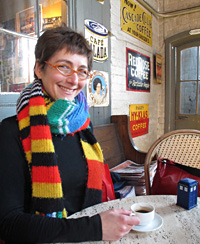I taught a couple of classes on Continental knitting this past weekend in New Hamburg. Now, some may question my qualifications to knit such a classes, since by default I knit English-style - that is, with my yarn in my right hand. I learnt that way, when I was very young, and I find that although it might not be the fastest method, it's very comfortable for me.
But that doesn't mean I don't use and enjoy the Continental method when it suits me. I'm all about having options!
Continental knitting has you hold your yarn in your left hand, like so:

English-style knitters, like me, usually find the Continental knit stitch easy to manage - it's easy to work, and the benefits are immediate and obvious.
Because the working yarn is stretched behind your needles, it's pretty easy to "pick" the stitch. Like so:

Just put the right-hand needle into the stitch, and swing the tip of the needle over top of the working yarn to the right, and bring the working yarn back through the stitch. Easy!
It's much more efficient in movement, since you're not moving the yarn at all, and barely moving the needles.
I like to use the continental knit when I'm working a piece entirely in garter stitch, or when my hands are tired.
My gauge is quite different between the English and Continental methods, however, so I have to be consistent about which method I'm using in a project. This is true for many knitters - continental knitting is often looser than English knitter.
I must confess, however, that although I could (and would) do it, until recently I'd never really been fluid with the Continental purl.
No matter what method they learn, it seems that a lot of newer knitters dislike purling - they find it cumbersome and sort of unnatural. (They're not wrong; there is a theory among knitting historians that knitting in the round was invented first, and then the purl was a later adaptation to make it work flat.) A purl seems fiddly in English knitting, but downright unpleasant in Continental knitting. It's the pesky wrap.
What you save in movement in a Continental knit seems to get spent in the purl, trying to man-handle the yarn over the needle point and make it stay still while you move the needles.
There are a couple of common ways of wrapping the yarn for the Continental purl.
With your index (or middle) finger:

Or with your thumb (less "traditional", but I find this easier - I can pivot my thumb and let my fingers worry about holding the needles):

These work well, but don't feel elegant to me.
And then there's the Norwegian purl. I did some experimenting with it and reading about it before I taught the New Hamburg class, and I think it's changed my life.
In essence, instead of moving the yarn to work the purl, you move the needle. It's much closer to the method you use for the Continental knit stitch, in fact.
It goes like this...
Leave the yarn at the back (Yes, pause to think about that. No moving the yarn at all. Imagine how easy ribbing could be!) and put the needle into the stitch as normal for purling (that is, from back to front)...

And, leaving the yarn in place, move the tip of the right hand needle around the working yarn (as you do for a knit; think on that, too - makes it very easy and familiar)....

Then once the yarn is wrapped around the needle like this:

push the wrapped needle back through the stitch (from front back through to the back), like this:

For some knitters, it's a world-changer. I know it was for me. If you've been struggling with a Continental purl, try it.
Some knitters do still find it easier if you bring the yarn to the front, but still use the same basic technique.
You can read more about it, and see more pictures
here and
here on the blog of Knitty's Teresa.
Play with it and see how it works for you. Let me know how it goes!
 I have a mild obsession with the Noro yarns -I love the way they combine colour. A successful Noro design keeps the stitchwork simple and lets the colours show off. This classic and simple lace pattern causes the rows to scallop, making lovely wavy stripes.
I have a mild obsession with the Noro yarns -I love the way they combine colour. A successful Noro design keeps the stitchwork simple and lets the colours show off. This classic and simple lace pattern causes the rows to scallop, making lovely wavy stripes.


















